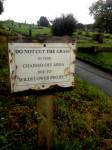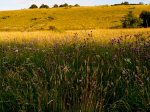A meadow is a field vegetated primarily by grass and other non-woody plants (grassland). The term is from Old English mædwe. In agriculture, a meadow is grassland which is not grazed by domestic livestock but rather allowed to grow unchecked in order to make hay. It may be naturally occurring or artificially created from cleared woodland. (source: Wikipedia)
What’s happened to our meadows?

Poppy Field (Photo: Meadow Project)
Over 95% of our native flowering meadows have disappeared since the war due to intensification in agricultural practice. UK meadows would traditionally have been part of our natural rural landscape and even today most people visualise a field of poppies and cornflowers when they think of a meadow.
Are there different types of Meadows?
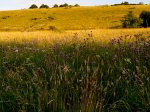
Martin Down grassland meadow (Photo by Richard Russell)
There are many types of meadows – grassland meadows, lowland meadows, water meadows, summer meadows, spring meadows and cornflower annual meadows. If you are considering a site for meadow creation you need to ask what would this land be in it’s natural state? A grassland meadow? A hay meadow? A water meadow?
It may be the right course to just leave the land untouched for a couple of years to allow any dormant seeds to get established, allowing nature to reclaim the area before you add or change anything. It’s also vital that you get the site checked for current plant species as you may find you are digging up naturally occurring wild flowers to replace them with your version of a meadow.
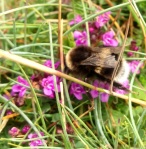
Bee gathering nectar (Photo: Meadow Project)
It’s worth noting that “The dominant plants of meadows are native, rather than cultivated, grasses, interspersed with a great variety of different herbaceous flowering plants. Most of the plants growing in meadows are fairly common species also regularly found in other habitats. With the notable exceptions of certain now rare species such as orchids, fritillaries and cowslips, the main value of meadows lies in the sheer diversity of their plant life. This affords a local concentration of a wide variety of invertebrate food plants, together with shelter for a great many different invertebrate species. This in its turn means that there is an abundance of food for birds and mammals. The actual plant species composition of meadows will vary from area to area, depending on local geological, soil and climatic conditions” (Source: http://www.countryside.info.co.uk)
How big should it be?
Obviously most of us do not have the luxury of a vast piece of land to play with and so I believe any area, however small that is turned over to wild flowers, or converted from treated mown grass to untreated meadow grass is an incredibly important asset for our communities and our local flora and fauna and can be achieved wherever we live. We call these mini meadows and it could be part of your lawn, a grass verge or a corner of your garden.

If you don’t feel inspired just take a look at this little mini meadow that
Owen Rogers created on his windowsill. It contains 15 nectar rich wild flower species to attract bees and butterflies. Owen tweeted “my local GC had wildflowers on sale and couldn’t resist!”

A nectar rich new meadow can be a road side verge or a green space around urban housing and tower blocks. It can be a ribbon edge between your mown lawn, garden beds, boundary or hedges.

Roadside verge Hogarth Roundabout, Chiswick West London (Photo: Meadow Project)
It can be in your public park. So talk to your local council and ask them why they are not planting perennial British wild flowers instead of annual sterile bedding plants. Ask your local council to leave unmown grass edges around their grassed areas; it costs less to maintain, and also creates a lovely wildlife rich area for local people to enjoy. Ask them to stop spraying your public green spaces with pesticides and weed killers. It’s bad for our environment and for our health and wastes our limited financial resources.
If the area you are thinking of converting is particularly small, don’t despair. Plant perennial wild flowers, they take less maintenance once established and come up year after year. If you are converting a mown grass area to a wild flower meadow, once established, a small area will be easier to manage and less time consuming than a manicured lawn. Once established, it only needs cutting once/twice a year, (make sure grass cuttings are removed). And a small area can be cut with hand shears and raked, and requires no ‘weed and feed’ chemical treatments.
Test your soil
Perennial wild flowers prefer infertile soil where as annual cornflowers can tolerate both fertile and infertile soil. So if you want a wild flower area or meadow that comes up year after year you may need to remove your top soil to reduce soil fertility. In addition you need to check what type of soil you are dealing with. Is it clay, sandy, loam, chalky? Pick up a basic soil testing kit from your garden centre to check your soil, and choose the wild flower plants that do well in the type of soil you have, otherwise you may be disappointed with the results.
Find a suitable site
Firstly, make sure that you are not disturbing rare or established nectar rich flowering plants or hedgerow. The ethos of Meadow Project is to add positively to our environment not diminish it in any way. A basic plant survey is a great tool and will tell you a lot about what already grows well in the area that you are choosing. If you are lucky to live near to the countryside or a piece of wasteland you can use it to see which local wild flowers are suitable for your area. Please do not remove plants from these areas but use it to gather information to select suitable seeds and plants which you can buy from reputable websites and garden centres. You can also contact The Postcode Plants Database which has useful information on plants that are specific to your area. The website was produced by Flora-for-Fauna, and enables you to generate local lists of UK plants (flora) and/or animals (fauna).
 Annual cornflower meadows do best in a sunny position with good drainage, though they may need watering during long dry periods. Perennial local wild flowers once established (after 2nd year) will pretty much fend for themselves as long as competitive weeds are kept under control. There are wild flowers that do well around hedgerows and in shady woodland conditions but if you want a perennial wild flower meadow you again need a site with reasonable sunny conditions and good soil drainage, unless you are creating a water meadow.
Annual cornflower meadows do best in a sunny position with good drainage, though they may need watering during long dry periods. Perennial local wild flowers once established (after 2nd year) will pretty much fend for themselves as long as competitive weeds are kept under control. There are wild flowers that do well around hedgerows and in shady woodland conditions but if you want a perennial wild flower meadow you again need a site with reasonable sunny conditions and good soil drainage, unless you are creating a water meadow.
Naturescape says “Sites suitable for a meadow within the garden are best positioned at the furthest end of the lawn from the house. If this extends into trees or wildlife hedge so much the better, with the object of becoming more wild as one moves away from the house. Grass banks can be made to look spectacular since they are often well drained and of low fertility, an ideal site for a meadow”
Choose the right seeds or plug plants for your soil and site
If you are sowing an annual wild flower meadow, you can sow in Autumn (October) for a Spring flowering meadow or in Spring (April) for a summer flowering meadow. If you are creating a perennial wild flower meadow you will have a better chance of success if you plant plugs rather than sow seeds.
Below are some ideas for suitable British wild flower plants, seeds and bulbs for a variety of situations by Habitat Aid. I have linked some of the plant names to the relevant page on the Habitat Aid site which offers a more detailed description and possibility to purchase. Each heading is also a direct link to wildflowers.co.uk with another comprehensive list of suitable plants for you to look at or purchase.
Shady/Woodland conditions
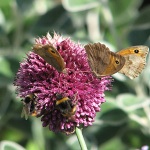
Ringlet Butterflies and bees on Round headed leek (Photo: Habitat Aid)
Round-headed Leek (Allium spaerocephalon)
Round-headed leeks are native, but rare in the wild. They work well in formal gardens planted in numbers, and are helpful nectar plants in June/July.

Anemone nemorosa (Photo: Habitat Aid)
Wood Anemone (Anemone nemorosa)
Beautiful woodland native, flowering in early spring. Does best in light shade. Good source of pollen for bees.

Lily of the Valley (Photo: Habitat Aid)
Autumn Crocus (Colchicum autumnale) Meadow Saffron, or Autumn Crocus, blooms in September when its beautiful pale purple flowers provide useful late forage for bees.
Lily-of-the-valley (Convallaria majalis)
Beautiful fragrant woodland native, flowering in June. Good source of pollen for bees. Flowers: Late spring
Fritillaries (Fritillaria)
Delicate and beautiful, the native Snakesehead fritillary, Fritillaria mealeagris, is now rare in the wild but is a beautiful plant to grow in the garden.
Solomon’s Seal (Polygonatum x multiflorum)
Graceful tall woodland native, flowering in June. Good source of nectar for bees. Flowers: April – May
Semi Shade
Chives (Allium schoenoprasum var anglicum) An attractive form of chive, native to Britain.

Red Campion (Photo: Habitat Aid)
Red Campion (Silene dioica) Lovely rose-pink and long flowering perennial of light shade. good nectar sources for moths and therefore help to sustain out native bats. Campion Moths lay their eggs in the flower head, and the growing caterpillars feed on the seeds.
Foxglove (Digitalis purpurea) Beautiful and evocative native foxglove; a helpful plant for shade and bumblebees.

Yarrow (Photo: Habitat Aid)
Sunny
Yarrow (Achillea millefolium) Flat white flower heads, much visited by butterflies and hoverflies. Drought tolerant, requires well drained infertile soil.
Agrimony (Agrimonia eupatoria) Spikes of attractive yellow flowers in high summer
Lesser Knapweed (Centaurea nigra) Thistle like perennial flowering all summer long. Great nectar plant, probably the best in terms of its wildlife value.

Meadow Cranesbill (Photo: Habitat Aid)
Meadow Cranesbill (Geranium praetense) Pretty, resilient plant of grassland and scrub.
Field Scabious (Knautia arvensis) Beautiful plant, typical of chalky grassland.

Oxeye Daisy (Photo: Habitat Aid)
Oxeye Daisy (Leucanthemum vulgare) Cheerful long flowering perennial, early colonizer. Annually cut and thoroughly rake your meadow to open up spaces for plant’s seeds to fall and germinate, maintaining its presence in your meadow
Common Toadflax (Linaria vulgaris) Lovely yellow flowers, grows on dryer soils and in most locations, where its seed can be sown at any time of year.

Yellow Rattle (Photo: Habitat Aid)
Cowslip (Primula veris) Beautiful early harbinger of spring, now surprisingly difficult to find in the wild. Cowslips thrive in well drained but moist soils, and need an open sunny site. Cowslip seed needs a period of cold before germinating, so should be sown in autumn.
Yellow Rattle (Rhinanthus minor) Seed Yellow Rattle is an attractive semi-parasitic annual which will significantly reduce the vigour of most grasses, and is consequently a useful plant in meadow management. grassland of low to medium fertility and with a balanced sward which is not dominated by coarse vigorous grasses. To sow Rattle into existing grass, cut or graze it short (25mm) and harrow, rake, or lightly disc, aiming to create up to 50% bare soil. Sow in autumn or early winter up to Christmas.
Wet
Autumn hawkbit, Birdsfoot trefoil, Common knapweed, Creeping bent, Crested dogstail, Meadow buttercup, Meadow sweet, Ox-eye daisy, Ribworth plantain, Rough hawkbit, Rough-stalked meadow grass, Selfheal, Slender creeping red fescue, Yellow rattle
Coastal
Viper’s Bugloss (Echium vulgare) Biennial much loved by bumblebees, tolerant of very dry conditions, prefers sandy soils, long flowering period.
Biting Stonecrop, English Stonecrop, Evening Primrose, Jersey Thrift, Rock Samphire, Rock Sea Spurrey, Sea Arrow Grass, Sea Campion, Soapwort, Thrift, White Stonecrop
Prepare your site
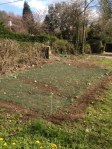
Prepared area, sown and covered in netting (Photo: Meadow Project)
Remove weeds, roots, and top soil to remove fertile layer. Dig over the area and rake to a fine tilth. Where possible leave for 6 weeks to allow dormant seeds to emerge. You may find you already have a wild flower store of seeds waiting to emerge so monitor what comes up and remove unwanted seedlings.
Sow your wild flower seeds
Choose a non windy and cool day if possible to sow your seeds. Mix your British wild flower seeds with fine dry sand in a bucket to help to sow evenly across the newly prepared area. Broadcast sow in waves and repeat in opposite direction to give a natural flowing look. Gently firm the seeds into the soil by methodically walking across the area. Water in gently making care not to wash the seeds away. Cover the area with netting to protect from birds until the seedlings emerge and are a couple of centimetres high. Make sure you leave the netting secured close to the ground and regularly check that no birds or wildlife are trapped in it.
Plant your perennial plug plants.
Make sure to position your plant plugs in a flowing design rather than rows and intermingle different plants to create a more natural look. Do not add compost or feed, remember most perennial wild flowers prefer poor soil. Mix in annual British wild flower seeds to infill any areas in the first year as some of the wild flower perennials may not flower in the first year. Firm in plug plants and water in well. Keep watered for the first 2-3 weeks to encourage healthy deep roots.
